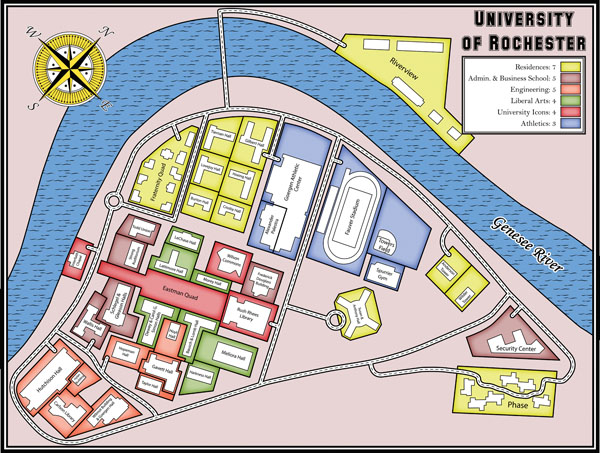Alumni Gazette
 SO LONG, GENTLE WATERS: Rochester’s blissful riverside campus is carved into strategic territories on Costanza and Stutzman’s Risk-style University of Rochester gameboard. (Photo: Courtesy of Luke Costanza ’09 and Mac Stutzman ’09)
SO LONG, GENTLE WATERS: Rochester’s blissful riverside campus is carved into strategic territories on Costanza and Stutzman’s Risk-style University of Rochester gameboard. (Photo: Courtesy of Luke Costanza ’09 and Mac Stutzman ’09)“Have you ever visited a new place and asked yourself: What is the best way to conquer this territory? What are the key defensive positions for moving armies? And what are the choke points?”
Luke Costanza ’09 posed just those questions last spring in a video uploaded onto Kickstarter.com.
Havoc on the River Campus?
How would the two longtime friends and game enthusiasts capture the River Campus? In top-secret strategy sessions, we asked each separately how they would defeat the other.
Costanza
“If I were playing against Mac, just because I know how to get in his head, I’d pretend that I was going after the liberal arts, just because that’s his background and I know that I could really get under his skin by trying to go for Lattimore or Morey. “But I think my secret plan would be really to go after the engineering buildings. My major was optics, so I was over in that quadrant a lot. And it gives a good amount of bonus units for the small number of choke points it has. So in essence, if you can control Hutchison Hall, Hopeman, and Hoyt, then you can protect the rest of your engineering buildings just by blocking those three paths. “
And then I’d probably go for the Frederick Douglass building because I used to have many meals there. I’d have to feed my army. I’d have to have supply lines.”
Stutzman
“If I were going against Luke, he’s an engineer, so I think he’d go after the engineering buildings. I also know that he likes to start small and really build up. “So I think I would start big, and I would go after the residence halls. Specifically Sue B., because I would catch the freshmen unaware. They’d be tripped out from all that homestyle cooking at Danforth, so they’d be an easy target. Meanwhile, Luke would probably have extended out a bit from engineering. I think it would come to a big showdown in the quad.”
With the battle raging around him, would President Seligman have anything to worry about?
According to Costanza, maybe not.
“The administration is actually fairly difficult to hold on this map. Their buildings are so spread out. You actually have to hold a good amount of them.”
The tongue-in-cheek video served an earnest purpose: He and Mac Stutzman ’09 were vying to raise $20,000 on the online funding resource to turn an idea into a business. At midnight last July 17, their 45-day campaign closed with $25,348, minus a small cut for Kickstarter, in the bank. That’s enough for the two to finance their new company, Bungled Board Games, and launch their first line of products, called Havoc Boards.
Brothers in the Phi Kappa Tau fraternity, Costanza, an optics major, and Stutzman, a history major, were big fans of the Hasbro board game Risk. After graduation, as roommates in Boston, they continued to play, and on a whim, drew up their own game board—a map of Boston—and invited friends over to play.
The Boston board was a hit. Soon the two had created on a home computer game-style maps of the United States, the United Kingdom, and New York City, and arranged for a board game manufacturer to create prototypes of the three boards.
“We can do any map,” says Costanza. In fact, they’ve created designs for 15 game boards so far, among them, boards featuring maps of Washington, D.C., Austin, Texas, Portland, Ore., the solar system, and even the River Campus.
But those with their eyes on Jupiter—or even Wilson Commons—may, at this point, want to consider a laser engraved wooden game board as opposed to standard cardboard.
“The whole idea for Havoc Boards kind of clicked when Luke had the idea of laser engraving,” says Stutzman. It solved a problem of economies of scale. Since each design would require a separate printing run, the only game boards it would make sense to print on cardboard were those Costanza and Stutzman were confident they could sell in large quantities. Laser engraving on wood provided a means to offer custom boards on demand.
With funds raised from their successful Kickstarter campaign, however, they’ve been able not only to embark on mass production of the original three prototypes, but also to produce a few additional boards as well.
Has Hasbro, the creator of Risk, had anything to say?
“We haven’t been contacted,” says Costanza. “I’m not sure if we expect to be contacted by them.”
Game play, he explains, can’t be owned. Only the name, artwork, or instructions, for example, can be covered by patents and trademarks. He cites the proliferation of Monopoly-style game boards as a precedent. “You can go to Barnes and Noble and find a [Monopoly-style] board for Rochester,” says Costanza. “That’s not made by Hasbro,” which created Monopoly as well as Risk.
But there’s a plus to Havoc Boards, Costanza contends. “In Monopoly, the game doesn’t really change.” With Havoc Boards, “every map is actually a completely different game, because some places have more territory, some have less, some have crazier ways to attack one thing from another.”

